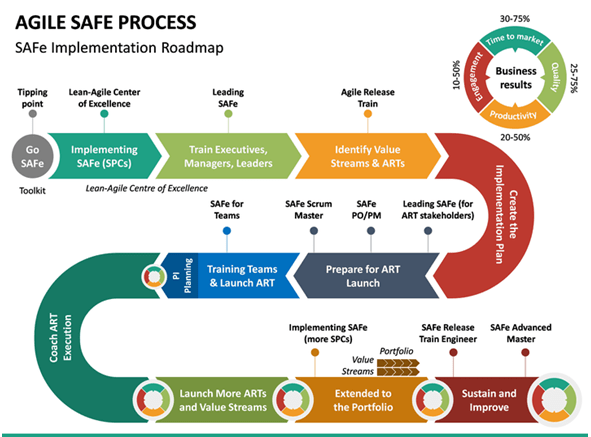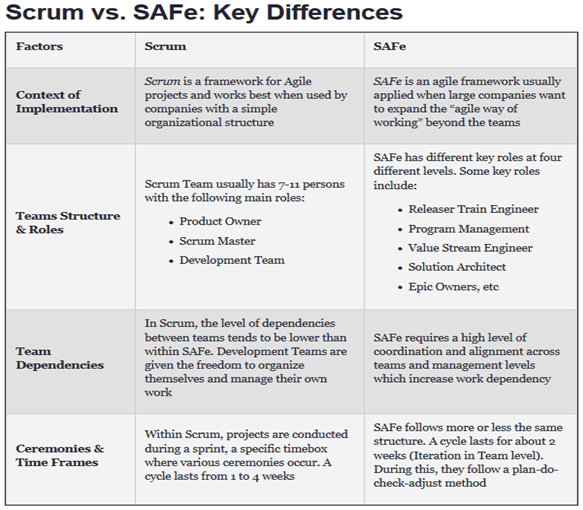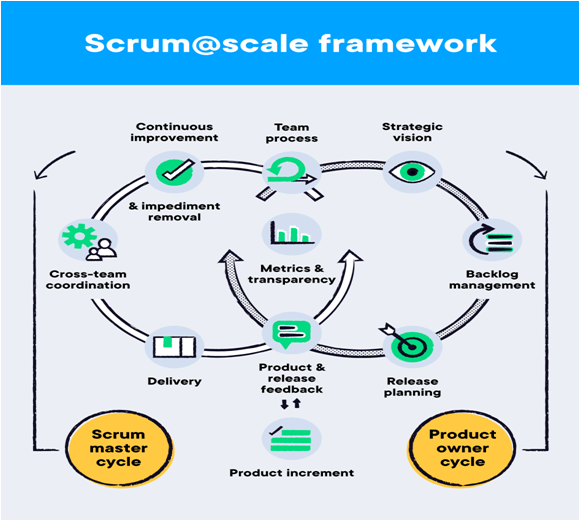Scrum is an Agile framework that emphasizes iterative development through short, focused sprints. It’s well-suited for smaller teams working on projects with evolving requirements. SAFe (Scaled Agile Framework) is a comprehensive approach designed for larger enterprises. It offers guidance on coordinating multiple Agile teams, aligning them with strategic goals, and facilitating collaboration across the organization. SAFe scaled Agile practices to address complex projects and organizational structures.
What is SAFe?
The Scaled Agile Framework (SAFe) empowers organizations to attain objectives while meeting customer demands effectively. In contrast, Scrum’s approach is narrower, employing smaller teams. SAFe provides a comprehensive structure, coordinating numerous groups and leaders for delivering products of significant size or complexity.
While SAFe introduces more structure compared to Scrum’s flexibility, it maintains continuous development. Teams within SAFe pursue varied objectives, contributing to common end goals. SAFe’s foundation rests on three pivotal principles:
- Lean Product Development: This approach curbs waste and enhances process efficiency. It ensures sustained productivity during ongoing development
- Agile Software Development: SAFe employs incremental changes in response to feedback and emerging demands. Although slightly less flexible than Scrum, SAFe accommodates swift adaptations in development.
- System Thinking: SAFe adopts a holistic approach to designing products, incorporating all system aspects. This strategy illuminates the interconnectedness of components within larger systems.

Strengths and weaknesses of SAFe:
Strengths:
- Helping businesses become more agile and competitive.
- Boosting teamwork and collaboration among teams.
- Introducing safeguards to avoid product issues.
- Enhanced operations on an enterprise-wide scale.
Weaknesses:
- Not suitable for small businesses and startups.
- Teams need to adopt a common Agile language.
- Depends on a stricter, top-down framework.
For whom is SAFe most suitable?
SAFe works best for organizations that practice Agile at an enterprise scale. Specifically, it suits organizations that:
- Manage multiple teams
- Implement leadership through top-down guidance.
- Build sophisticated solutions that involve multiple teams working together.
What is Scrum?
Scrum, an Agile framework, champions efficiency through small, self-organized teams that swiftly deliver top-tier software. Embracing simplicity, Scrum fosters adaptability, enabling teams to respond to stakeholder input effectively. Complex projects are tackled methodically by breaking them into manageable steps.
Cross-functional teams in Scrum hold the power to tackle diverse challenges and project types, ensuring productivity and cost-effectiveness amid shifting requirements. This streamlined approach facilitates open communication, providing clarity on specific concerns. This setup not only encourages collaboration but also facilitates thorough work review.
At the core of Scrum development are three pivotal roles:
- Product Owners: These individuals align team goals with the expectations of customers and stakeholders. Their insights and feedback shape product requirements.
- Scrum Masters: Responsible for overseeing both team and process, Scrum Masters eliminate hindrances to maintain the team’s momentum and focus.
- Scrum Teams: Working closely with Product Owners and Scrum Masters, these teams execute goals outlined in each sprint planning phase. They are the dedicated builders of the final product, empowered to bring ideas to fruition.

Strengths and weaknesses of Scrum:
To better understand Scrum, here are its main advantages and drawbacks.
Strengths:
- Enhanced development procedures for optimal outcomes.
- Prioritizing user needs and desires.
- Speedy delivery periods.
- Smooth coordination in small team settings.
Weaknesses:
- Complexity in adapting to sizable projects.
- Mandates training for the entire team.
- Development cycles might not consistently match project deadlines
For whom is Scrum most suitable?
Scrum is a great fit for small organizations and independent teams. It’s particularly useful in scenarios where:
- There’s a need for frequent input and feedback from stakeholders and customers.
- The deliverables are subject to changes and require teams to be adaptable.
- Short timeframes are in play, necessitating the delivery of high-quality products quickly.

How to choose the best framework for your team.
The right Agile approach for an organization depends on its goals, structure, and processes. When picking between SAFe vs. Scrum, keep the following factors in mind.
Organization structure.
Scrum and SAFe cater to distinct organizational needs. Scrum is optimal for small companies or those with independent teams, while SAFe is better suited for larger enterprises where interconnected teams collaborate seamlessly.
Development philosophy.
Scrum strives to provide continuous development at a low cost. Self-contained teams can organize themselves to quickly deliver high-quality software and make regular improvements over time. This creates a feeling of project ownership that Scrum teams may fail without.
On the other hand, SAFe is designed to enable large businesses or organizations to be nimble and agile while ensuring stability and structure for their teams. SAFe follows a more formalized strategy of setting clear targets based on a client’s needs. From there, teams rigidly pursue those goals within preset guidelines. While it gives room for flexibility and updates, SAFe development involves more oversight and structure. After all, requirement changes make waves through more than one self-contained group.
Implementation Strategy.
The implementation strategy for Scrum or SAFe should align with your overarching objectives:
- Opt for Scrum when you require a small, cohesive team to handle projects with straightforward objectives.
- Choose SAFe to foster unity across your entire organization, bearing in mind that this demands inter-team collaboration.
Processes:
Scrum relies on adaptable, lightweight techniques that segment extensive projects into manageable phases. Regular evaluation of deliverables is essential to avert issues. This method sustains progress, even in complex undertakings, and facilitates fine-tuning based on stakeholder feedback.
Contrastingly, SAFe employs more defined roles that don’t rely on small, flexible teams. SAFe processes ensure high-quality output and cross-organizational collaboration. While it demands more substantial planning, it offers broader resource capabilities.
Framework Requirements: For Scrum implementation, a single team suffices. Ideally, this team should exhibit substantial autonomy and self-management. On the contrary, SAFe necessitates deeper organizational commitment. Teams must be open to shared goals and processes, fostering a more unified approach.
Team Roles and Structure: Scrum suits small teams comprising around twelve or fewer members. Within Scrum, tasks are allocated among the Product Owner, Scrum Master, and the Scrum team. In certain cases, Scrum can even structure an entire startup or small business.
SAFe spans multiple teams throughout an organization. Individuals ranging from entry-level staff to high-level engineers collaborate harmoniously. It incorporates roles such as:
- Release Train Engineers
- Program Managers
- Value Stream Engineers
- Solution Architects
- Epic Owners
- Product Owners

Despite their disparities, Scrum and SAFe share numerous commonalities. As Agile frameworks, they are rooted in similar principles. We will elucidate their primary areas of convergence below:
- Team-based Development: Both Scrum and SAFe prioritize team collaboration over individual efforts. Coordinated teamwork across one or more teams propels the production process.
- Incremental High-Quality Deliveries: Both methodologies advocate for delivering superior products through incremental steps. While Scrum divides tasks into increments within a single team, SAFe extends this approach across multiple teams.
- Stakeholder Cooperation: Agile methodologies underscore collaboration with stakeholders. Jointly, they evaluate requirements, exchange feedback, incorporate customer input, and make necessary adjustments before or after product deployment.
- Inspect and Adapt Strategies: Regular evaluations and adaptive adjustments are integral. Scrum employs reviews after each sprint, while SAFe integrates these evaluations throughout the release train. Development priorities can shift based on these assessments.
- Timeboxing: Time management is facilitated through timeboxing in both approaches. This technique involves allocating a predefined duration to complete an activity. Adhering to these timeboxes ensures project progress.
- Continuous Delivery Pipelines (CDP): Both Scrum and SAFe implement continuous delivery pipelines. This strategy entails frequent software updates at regular intervals, utilizing automation to expedite products through testing, staging, and production phases.







